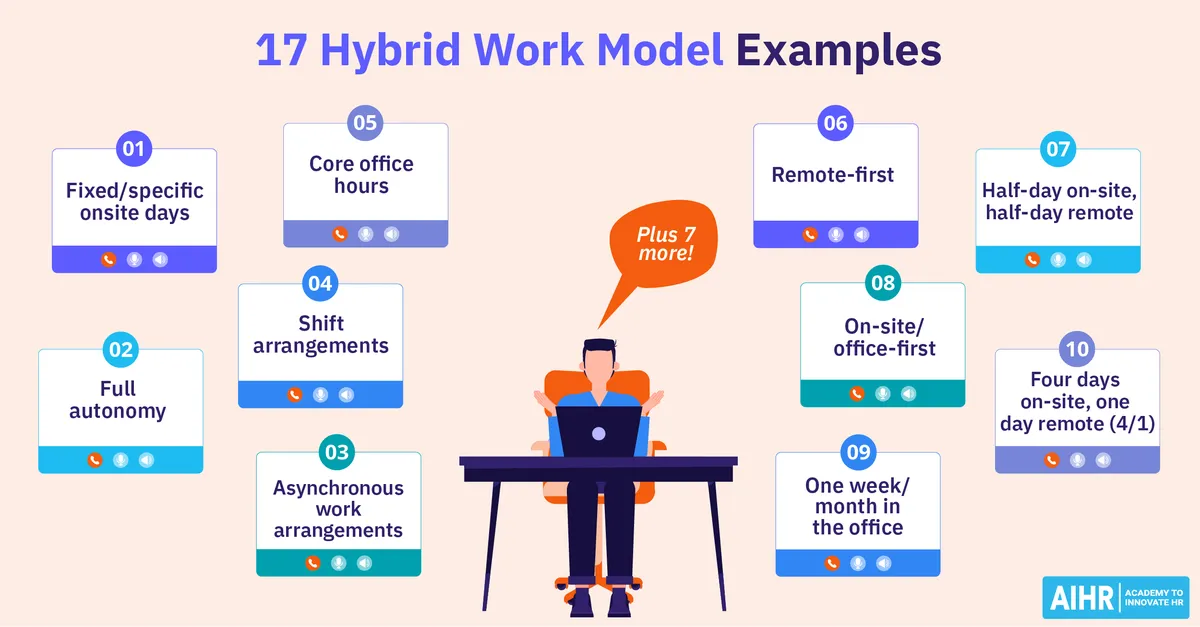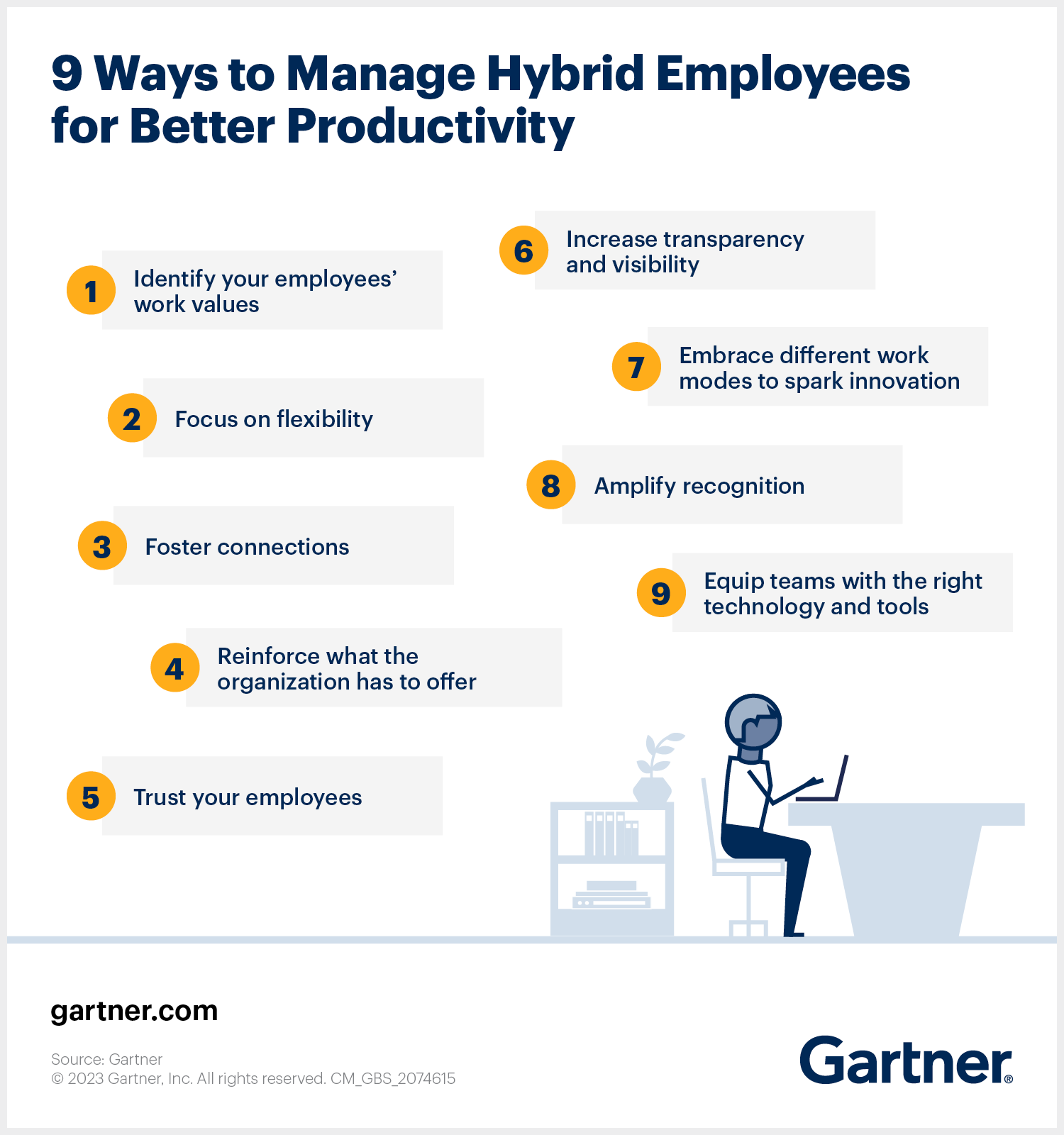How Hybrid Work Models Are Shaping Employee Productivity
Work-life balance coach helping remote professionals thrive.

Work-life balance coach helping remote professionals thrive.

Hybrid work models blend in-office and remote work. Employees split their time between working from a central office and working from home or another remote location. This approach offers flexibility while maintaining some face-to-face interaction.
Research indicates that a significant portion of the workforce now prefers this balanced approach. For example, a study by Gallup shows that hybrid work improves work-life balance, efficiency, and autonomy.
The concept of remote work isn't new. It gained traction with the rise of the internet. The COVID-19 pandemic dramatically accelerated its adoption.
Companies were forced to adapt quickly, leading to widespread remote work. Now, many are embracing hybrid models as a long-term solution, recognizing the benefits of both remote and in-office work.
Hybrid models vary widely. Some companies require employees to be in the office a few specific days a week. Others set a minimum number of days without specifying which ones.
Some offer complete flexibility, allowing employees to choose when and where they work. According to Scoop's Flex Index, about 37% of US companies are now working off a structured hybrid model as of early 2024.

Hybrid work empowers employees to choose their optimal work environment. This autonomy can lead to higher job satisfaction and productivity. A study by Stanford University found that hybrid work had zero effect on workers' productivity.
Employees can work when they feel most productive. They can also tailor their environment to suit their needs.
Commuting is a major source of stress and lost time. Hybrid models reduce or eliminate commute time on remote days. A study by Upwork reports that one-third of hiring managers saw increased productivity due to their remote work model.
Employees gain back valuable time. They can use this time for work, personal activities, or simply relaxing, leading to better work-life balance.
Balancing work and personal life is crucial for well-being. Hybrid work offers the flexibility to manage both effectively. Parents can attend school events, and individuals can schedule appointments without taking time off.
This balance reduces burnout and improves overall job satisfaction. USA Today states that 42% of office workers would take a 10% pay cut to have the flexibility to work remotely.
Effective communication is vital in any work setting. Hybrid environments can create communication challenges. A survey from 2022 revealed that 65% of hybrid workers feel they face communication barriers more than their fully remote or in-office counterparts.
It can be difficult to ensure everyone is on the same page when some team members are remote. Tools like video conferencing and instant messaging help, but they require careful management.
Remote work can lead to feelings of isolation. Employees may miss the social interaction of the office. This is especially true for those new to the company or role.
Maintaining a sense of connection requires effort. Regular check-ins and virtual social events can help bridge this gap.
Working from home requires strong self-discipline. Distractions are plentiful, and it can be hard to separate work from personal life. This can lead to burnout if not managed properly.
Clear boundaries and time management techniques are essential. Employees need to establish routines and stick to them to maintain productivity.

Measuring productivity in hybrid teams requires a shift in focus. Traditional metrics like hours worked are less relevant. Instead, companies should focus on outcomes and deliverables.
Key performance indicators (KPIs) should be tailored to each role. Examples include project completion rates, customer satisfaction scores, and sales targets. Clear, measurable goals help employees stay focused and motivated.
Various tools can help track productivity in hybrid settings. Project management software like Asana or Trello allows teams to track progress and manage tasks. Communication platforms like Slack or Microsoft Teams facilitate real-time collaboration.
Time tracking tools can also be useful, though they should be used to gain insights, not to micromanage. The right technology can bridge the gap between remote and in-office employees.
Research provides valuable insights into hybrid work productivity. A study by Nicholas Bloom at Stanford University found that hybrid work boosted employee retention rates by 33%. Trip.com, a participant in the study, saved millions due to reduced attrition.
These findings highlight the positive impact of hybrid models. They also underscore the importance of proper management and support.

Clear communication is the cornerstone of successful hybrid work. Teams should establish guidelines for when and how to communicate. This includes preferred channels for different types of communication.
Regular updates and check-ins are crucial. They ensure everyone stays informed and connected.
Regular team meetings are essential for maintaining alignment. These meetings should have clear agendas and objectives. They provide an opportunity to discuss progress, address challenges, and foster team cohesion.
Individual check-ins are also important. They allow managers to provide support and address any concerns.
Project management tools help teams stay organized and on track. These tools provide a central hub for all project-related information. They enable teams to assign tasks, set deadlines, and track progress.
This transparency ensures everyone knows what needs to be done. It also helps in identifying and resolving any bottlenecks.
Building a strong team culture is vital, even in a hybrid setting. Virtual team-building activities can help foster a sense of community. These can include online games, virtual coffee breaks, or shared interest groups.
These activities help team members connect on a personal level. Stronger relationships lead to better collaboration.
Feedback is crucial for growth and improvement. Hybrid teams should establish mechanisms for regular feedback. This can be through one-on-one meetings, surveys, or anonymous suggestion boxes.
Recognition is equally important. Celebrating achievements, both big and small, boosts morale and motivation. Public acknowledgment, even in a virtual setting, can have a significant impact. A simple thank you can shift the mood of the entire office.
Hybrid work is here to stay. The landscape will continue to evolve. Companies are experimenting with different models to find what works best for them.
Expect to see more variations in hybrid arrangements. Technology will play an increasingly important role in facilitating seamless collaboration.
By 2025, hybrid work will likely be the norm for many industries. Remote work trends are set to transform dramatically. Advancements in technology will enable even greater flexibility.
Employee well-being will be a central focus. Companies will prioritize creating supportive environments, regardless of where employees work.
Organizations need to be proactive in adapting to these changes. This includes investing in the right technology and providing training for both managers and employees. Fostering a culture of trust and flexibility is also key.
Regularly assessing and adjusting hybrid policies will be crucial. This ensures they continue to meet the needs of both the business and its employees. Organizations should be tracking how those answers change with time.

Hybrid work models are reshaping employee productivity. They offer numerous benefits, including increased flexibility, reduced commute times, and enhanced work-life balance. However, they also present challenges, such as communication barriers and feelings of isolation.
As we move forward, organizations must continue to adapt. Embracing flexibility, investing in technology, and fostering a supportive culture will be key to success. The future of work is flexible, and it's time to embrace it.
Key Takeaways:
— in Remote Teams
— in Remote Teams
— in Future of Work
— in Work-Life Balance
— in Mental Health